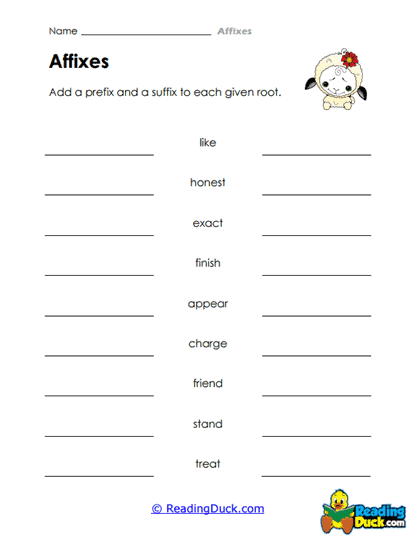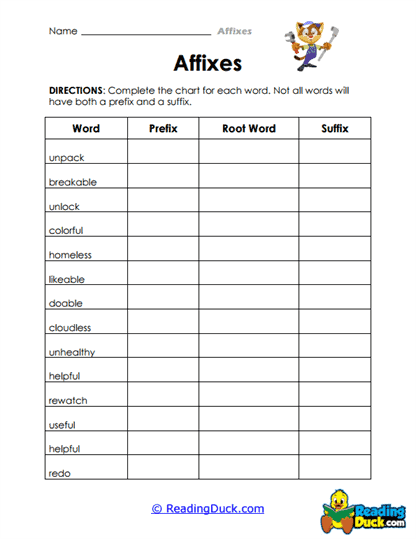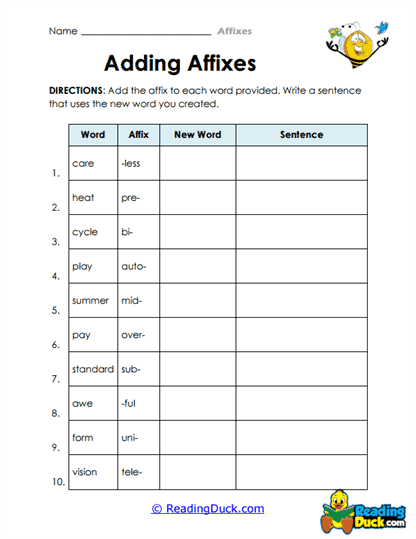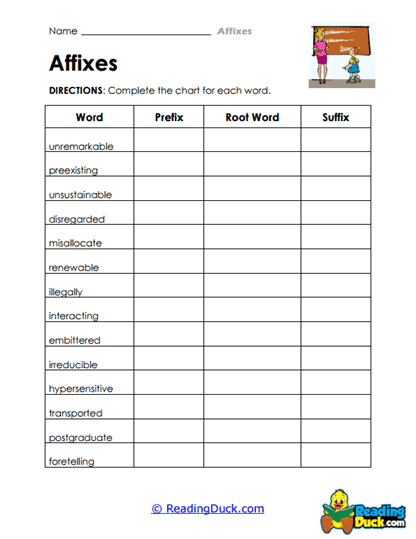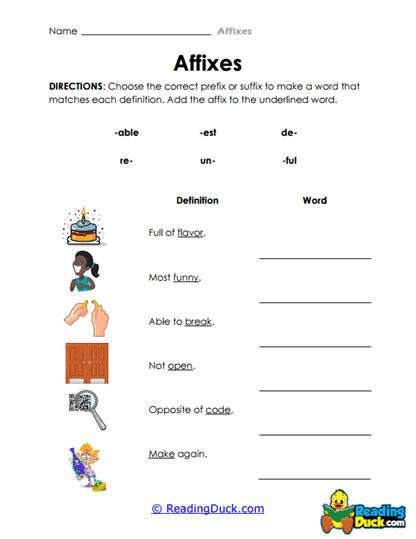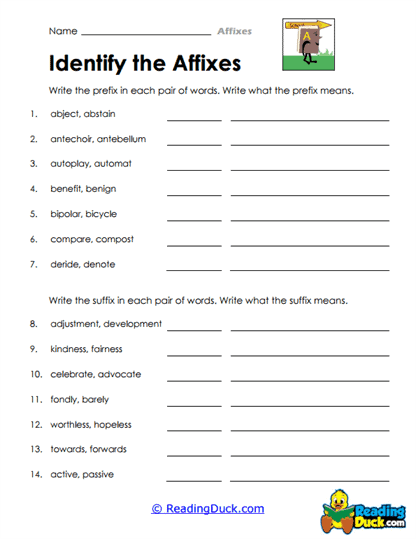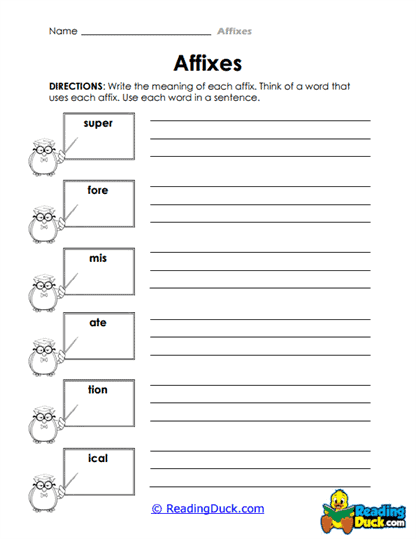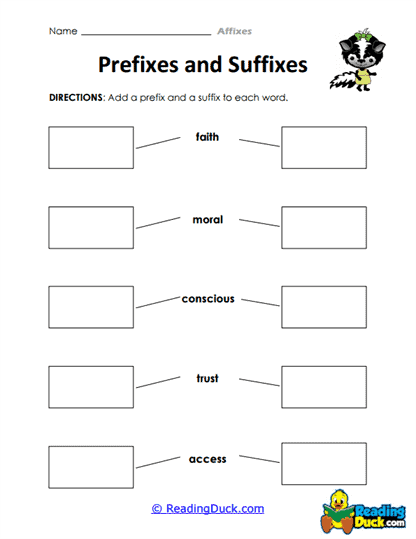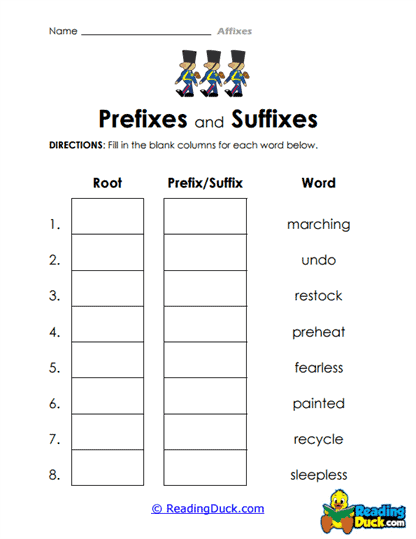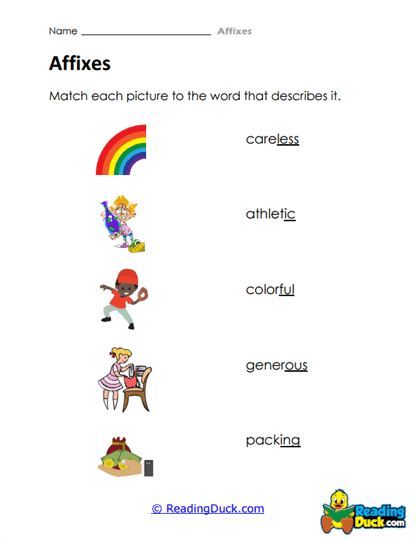Affixes Worksheets
About Our Affix Worksheets
Our collection of Affixes Worksheets is a valuable tool designed to help students strengthen their language and literacy skills. Falling under the Language category within the Skills section, this collection focuses on teaching students how affixes—both prefixes and suffixes—function in words to alter meaning and create new vocabulary. Understanding and applying affixes is a crucial part of language development, enabling students to expand their word knowledge, comprehend complex text, and improve both their reading and writing skills.
These worksheets are presented in a convenient PDF format, making them simple to view, download, and print for ease of use in both classroom and home learning environments. Additionally, each worksheet includes a downloadable answer key to provide immediate feedback, allowing students to check their work and reinforce their understanding as they progress.
What Are Affixes?
Affixes are linguistic elements added to the base or root of a word to change its meaning. They are one of the most fundamental building blocks of language, playing an important role in word formation and expanding vocabulary. Understanding affixes helps students deconstruct unfamiliar words, making it easier for them to infer meaning based on the parts of the word they recognize.
Types of Affixes:
There are two primary types of affixes: prefixes and suffixes.
Prefixes: A prefix is an affix added to the beginning of a root word. It changes the word’s meaning without altering its grammatical category (such as noun or verb).
-
- Example: "Un-" in "unhappy" changes the meaning of "happy" to its opposite, resulting in a word that means "not happy."
Suffixes: A suffix is an affix added to the end of a root word. Suffixes often modify the grammatical function of a word, such as turning a verb into a noun or an adjective.
-
- Example: "-ness" in "happiness" transforms the adjective "happy" into the noun "happiness," which represents the state of being happy.
Key Points About Affixes:
- Affixes help students recognize patterns in language, which is important for developing a deeper understanding of vocabulary.
- They can alter not just the meaning but also the grammatical function of a word.
- Affixes come from a variety of linguistic origins, particularly Latin and Greek, which makes them relevant for understanding academic vocabulary.
By learning about affixes, students can quickly expand their vocabulary and decode unfamiliar words. This understanding fosters greater independence in reading, writing, and speaking as students encounter increasingly complex texts.
The Various Usages of Affixes
Affixes are highly versatile and serve multiple functions in language. They help form new words, adjust meanings, and alter word classes. Here are some of the common usages of affixes and examples to illustrate their roles:
- Creating Opposites: Many prefixes are used to form the opposite meaning of a word.
- Prefix Example: "Dis-" in "disagree" transforms "agree" into its opposite, meaning "to not agree."
- Prefix Example: "Im-" in "impossible" turns "possible" into the opposite, meaning "not possible."
- Indicating Time or Order: Prefixes are also used to show when something happens or its order in a sequence.
- Prefix Example: "Pre-" in "preview" means "before," suggesting that you view something before the main event.
- Prefix Example: "Post-" in "postpone" means "after," indicating a delay.
- Changing Word Forms: Suffixes often change the form of a word, allowing it to function as a different part of speech.
- Suffix Example: "-er" in "teacher" changes the verb "teach" into a noun, meaning "one who teaches."
- Suffix Example: "-ly" in "quickly" turns the adjective "quick" into an adverb, modifying how an action is performed.
- Expressing Degrees or Comparisons: Suffixes can also be used to compare or express degrees of quality.
- Suffix Example: "-er" in "faster" compares the speed of two or more objects or people.
- Suffix Example: "-est" in "smartest" suggests the highest degree of intelligence in a group.
- Forming Plurals or Tenses: In English, suffixes help form plural nouns or indicate different verb tenses.
- Suffix Example: "-s" in "dogs" turns the singular "dog" into the plural form.
- Suffix Example: "-ed" in "walked" shows that the action took place in the past.
Affixes are integral to the structure of many languages, and their usage enhances both written and spoken communication. As students become familiar with various affixes, they can effectively navigate and comprehend more sophisticated language structures.
The Role of Affixes in Literacy Development
Learning about affixes significantly contributes to students’ overall literacy development. As students encounter new and challenging words in their reading, understanding affixes equips them with the tools to break down and decode unfamiliar vocabulary. This skill is essential for improving reading comprehension, as it helps students grasp the meaning of complex texts without constantly referring to a dictionary.
For writing, affixes allow students to express themselves more clearly and efficiently. By adding prefixes and suffixes, they can modify the tone, tense, or specificity of their writing. This flexibility in word usage enables them to produce more nuanced and precise pieces of writing.
Affixes also play a crucial role in expanding vocabulary, which in turn makes students more fluent speakers. The more comfortable they are with recognizing and applying affixes, the more effectively they can convey ideas, respond to questions, and engage in discussions. As a result, students become more confident in their use of language across different contexts.
Fun and Interactive Activities for Learning Affixes
To reinforce what students learn through the Affixes Worksheets, educators can implement a range of engaging and interactive activities. These activities can be adapted to different learning environments, including traditional classrooms and homeschool settings. The worksheets are suitable for students in grades 2 through 6, depending on their proficiency levels.
- Affix Bingo (Grades 3-5): Create bingo cards with different prefixes and suffixes in each square. Call out root words, and students must find the corresponding affix on their card that would form a valid word. This fun and competitive game helps reinforce affix recognition in a dynamic way.
- Word Building Challenge (Grades 4-6): Give students a list of root words and a selection of prefixes and suffixes. Challenge them to create as many valid words as they can by combining roots with different affixes. Students can compete in groups or individually to see who can generate the most words.
- Affix Story Writing (Grades 3-6): Have students write a short story using a set number of words with affixes. For example, they may be asked to use at least five words with prefixes and five words with suffixes. This activity promotes creativity while encouraging students to apply what they’ve learned about affixes in a meaningful context.
- Affix Sorting Activity (Grades 2-4): Prepare a collection of root words and affixes on separate cards. Students must sort the affixes into categories such as prefixes and suffixes and then match them to the correct root words. This hands-on activity reinforces understanding through physical interaction with language elements.
- Create Your Own Word (Grades 4-6): Encourage students to invent new words by combining unfamiliar prefixes or suffixes with common root words. They can then write definitions for these new words and present them to the class. This imaginative activity helps students think about how affixes shape meaning in language.
These activities provide students with a range of approaches to explore and master affixes, making the learning process both enjoyable and effective.
The Practical Importance of Affixes in Everyday Life
Mastering affixes is an essential language skill with numerous real-life applications. Understanding how prefixes and suffixes work enables students to decode complex words, which is especially valuable in academic settings where advanced vocabulary is common. For example, students who understand scientific terms like "biology" (the study of life) can better grasp the meaning because they recognize the affix "bio-" (life) and the suffix "-logy" (study).
In professional contexts, familiarity with affixes can enhance communication by allowing individuals to use more precise language. Whether writing reports, reading technical documents, or engaging in professional dialogue, the ability to interpret and apply affixes improves overall language fluency.
In summary, learning affixes not only boosts students’ language proficiency but also empowers them with the tools to navigate and comprehend complex texts in everyday life. This collection of worksheets provides an excellent foundation for mastering affixes, offering students a pathway to becoming more confident and capable readers, writers, and speakers.
